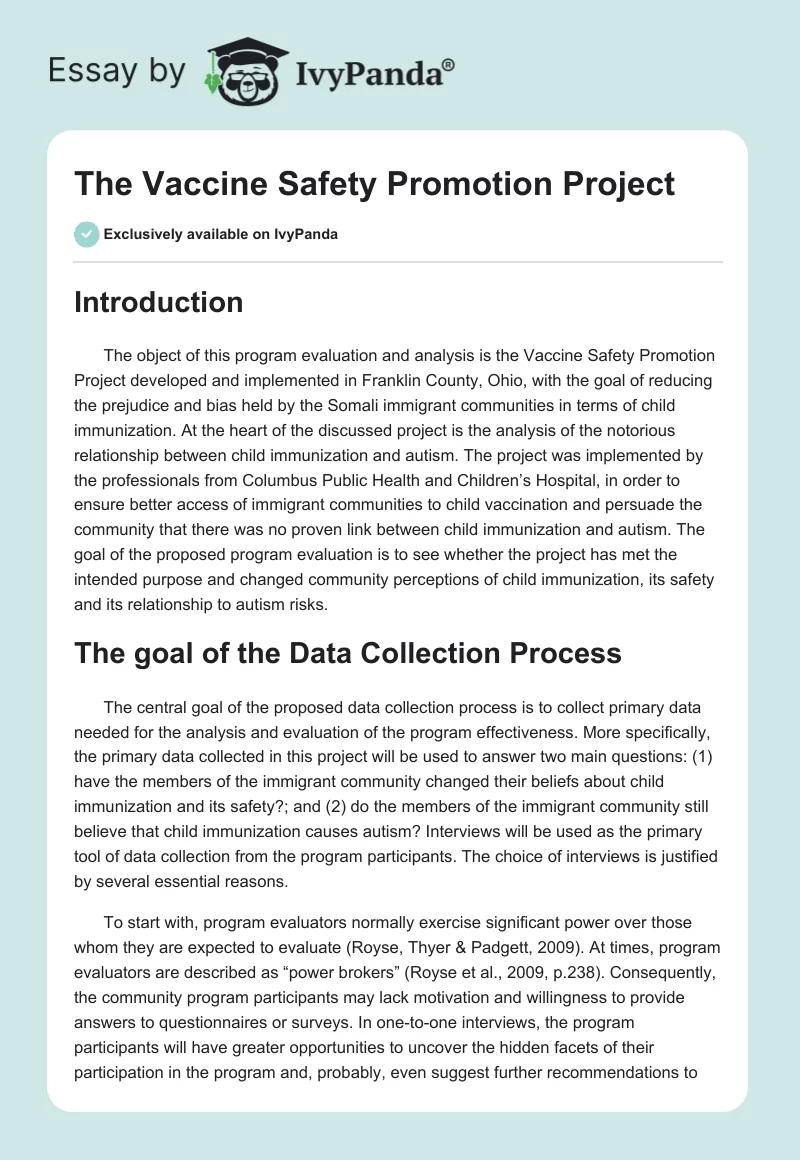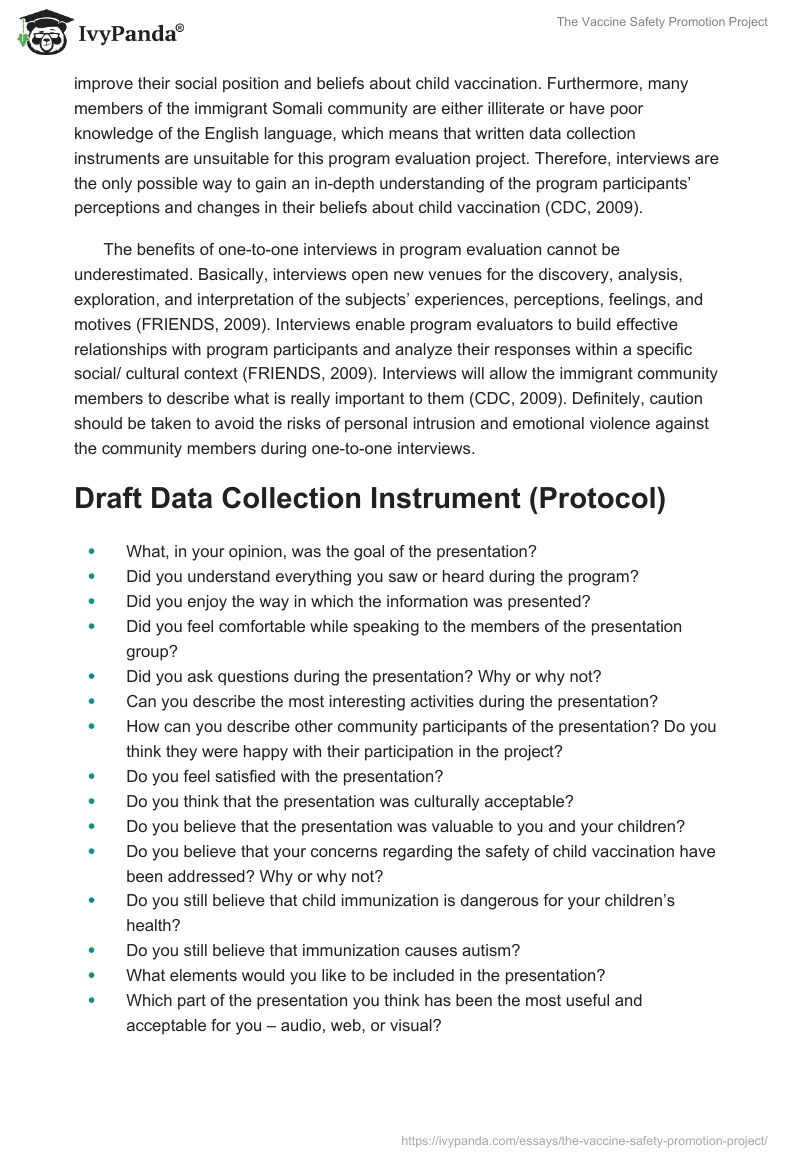Introduction
The object of this program evaluation and analysis is the Vaccine Safety Promotion Project developed and implemented in Franklin County, Ohio, with the goal of reducing the prejudice and bias held by the Somali immigrant communities in terms of child immunization. At the heart of the discussed project is the analysis of the notorious relationship between child immunization and autism. The project was implemented by the professionals from Columbus Public Health and Children’s Hospital, in order to ensure better access of immigrant communities to child vaccination and persuade the community that there was no proven link between child immunization and autism. The goal of the proposed program evaluation is to see whether the project has met the intended purpose and changed community perceptions of child immunization, its safety and its relationship to autism risks.
The goal of the Data Collection Process
The central goal of the proposed data collection process is to collect primary data needed for the analysis and evaluation of the program effectiveness. More specifically, the primary data collected in this project will be used to answer two main questions: (1) have the members of the immigrant community changed their beliefs about child immunization and its safety?; and (2) do the members of the immigrant community still believe that child immunization causes autism? Interviews will be used as the primary tool of data collection from the program participants. The choice of interviews is justified by several essential reasons.
To start with, program evaluators normally exercise significant power over those whom they are expected to evaluate (Royse, Thyer & Padgett, 2009). At times, program evaluators are described as “power brokers” (Royse et al., 2009, p.238). Consequently, the community program participants may lack motivation and willingness to provide answers to questionnaires or surveys. In one-to-one interviews, the program participants will have greater opportunities to uncover the hidden facets of their participation in the program and, probably, even suggest further recommendations to improve their social position and beliefs about child vaccination. Furthermore, many members of the immigrant Somali community are either illiterate or have poor knowledge of the English language, which means that written data collection instruments are unsuitable for this program evaluation project. Therefore, interviews are the only possible way to gain an in-depth understanding of the program participants’ perceptions and changes in their beliefs about child vaccination (CDC, 2009).
The benefits of one-to-one interviews in program evaluation cannot be underestimated. Basically, interviews open new venues for the discovery, analysis, exploration, and interpretation of the subjects’ experiences, perceptions, feelings, and motives (FRIENDS, 2009). Interviews enable program evaluators to build effective relationships with program participants and analyze their responses within a specific social/ cultural context (FRIENDS, 2009). Interviews will allow the immigrant community members to describe what is really important to them (CDC, 2009). Definitely, caution should be taken to avoid the risks of personal intrusion and emotional violence against the community members during one-to-one interviews.
Draft Data Collection Instrument (Protocol)
- What, in your opinion, was the goal of the presentation?
- Did you understand everything you saw or heard during the program?
- Did you enjoy the way in which the information was presented?
- Did you feel comfortable while speaking to the members of the presentation group?
- Did you ask questions during the presentation? Why or why not?
- Can you describe the most interesting activities during the presentation?
- How can you describe other community participants of the presentation? Do you think they were happy with their participation in the project?
- Do you feel satisfied with the presentation?
- Do you think that the presentation was culturally acceptable?
- Do you believe that the presentation was valuable to you and your children?
- Do you believe that your concerns regarding the safety of child vaccination have been addressed? Why or why not?
- Do you still believe that child immunization is dangerous for your children’s health?
- Do you still believe that immunization causes autism?
- What elements would you like to be included in the presentation?
- Which part of the presentation you think has been the most useful and acceptable for you – audio, web, or visual?
Instructions for Completion
Provided above is the protocol for the interviews to be conducted with the program participants. All interviews are to be conducted individually and confidentially. The fact that interviews are costly and time-consuming is well-known (CDC, 2009; Harris, 2010; Spaulding, 2008). However, there is no way to understand and estimate the impacts of the discussed program on the participants’ perceptions of immunization other than to conduct one-to-one interviews with each of them. Interviewees will not have to provide any personal demographic or other information. The goal of these interviews is to collect the primary data to be used in qualitative and quantitative data analyses. Each interview is expected to take between 1 and 1.5 hours. A total of 45 participants will be included in the sample. All interviews are to be conducted in the Somali language. All interviewees will have to provide their informed consent to participate.
Information to be Gained from Primary Data Collection
The goal of the proposed data collection instrument is to gain an in-depth understanding of the changes in the immigrant community’s perceptions of child immunization and its potential relationship to autism. Interviews exemplify one of the most promising mechanisms of primary data collection in the conditions of cultural diversity and low levels of community literacy. Interviews also represent an ideal approach to understanding community members’ feelings and perceptions of child immunization and its potential safety risks (CDC, 2009). The interview protocol is designed in ways that foster improved understanding of the participants’ feelings during and after the presentation, as well as the cultural or language barriers they might have encountered during the program. Answers to questions 12 and 13 of the interview protocol are decisive for assessing the quality and efficiency of the program, whose main purpose has been to change community beliefs about child immunization and autism risks. The interview will also give the participants an opportunity to express their recommendations for improvement and evaluate the most effective elements of the program design.
Conclusion
Interviews represent one of the most popular instruments of quantitative and qualitative data collection (Patton, 1999). The proposed interview protocol will become the central element of primary data collection for the discussed program. The interview protocol is designed in ways that enable program evaluators to evaluate participants’ feelings and perceptions of the program against their cultural and socioeconomic contexts. Answers to the interview protocol questions will provide the information required to evaluate the efficacy of the discussed program. All interviewees will also have a chance to provide their recommendations to improve the program and its design.
References
CDC. (2009). Data collection methods for program evaluation: Interviews.ETA Evaluation Briefs. Web.
FRIENDS. (2009). Using qualitative data in program evaluation: Telling the story of a prevention program. National Resource Center for Community-Based Child Abuse Prevention. Web.
Harris, M.J. (2010). Evaluating Public and Community Health Program. San Francisco, CA: Jossey-Bass.
Patton, M.Q. (1999). Enhancing the quality and credibility of qualitative analysis. Health Services Research, 34(5): 1189-1208.
Royse, D., Thyer, B.A. & Padgett,.K. (2009). Program evaluation: An introduction. Boston: Cengage Learning.
Spaulding, D.T. (2008). Program evaluation in practice: Core concepts and examples for discussion and analysis. NY: John Wiley & Sons.


